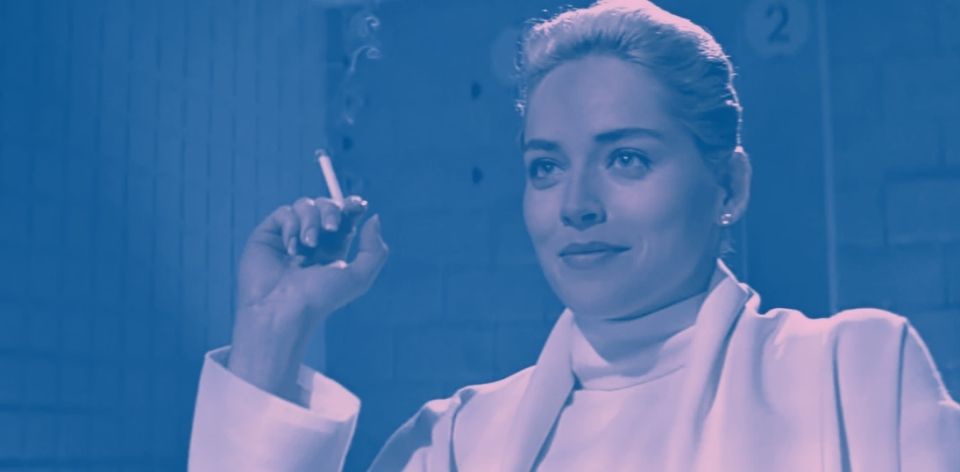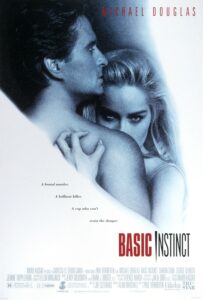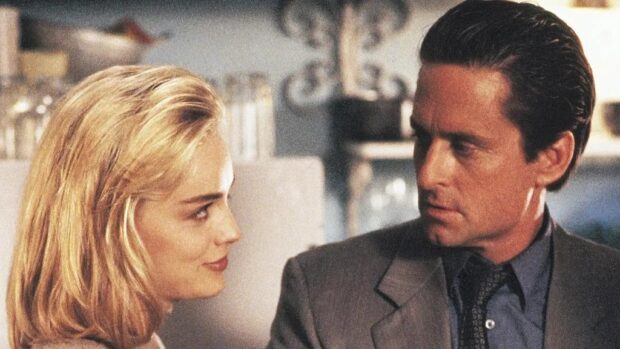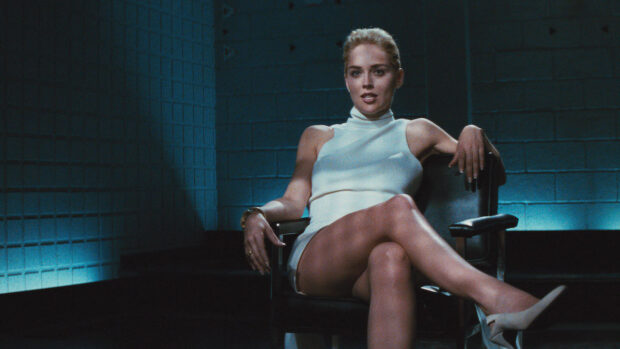“It’s not too difficult to see that BASIC INSTINCT is heavily influenced by Hitchcock’s Vertigo,” director Paul Verhoeven once told Caleb Hammond. Like the Master of Suspense, Verhoeven’s films have often straddled a line between sex and violence — and just as often at the expense of his female leads.
This week marks 30 years since one of Paul Verhoeven’s most infamous Hollywood films, the first of two partnerships between him and writer Joe Eszterhas, dropped on audiences. Amidst the ice pick jokes, the countless parodies and the controversy, it remains a curious piece of erotic neo-noir.
BASIC INSTINCT (1992) opens with arguably its second most infamous scene. An unseen blonde is in the throes of passion with rock star Johnny Boz, who is repeatedly stabbed only moments later with an ice pick. It’s the kind of ultraviolence Verhoeven had become know for since moving to Hollywood with Robocop (1987) and Total Recall (1990), now combining it with the innately sexualised content of his early work.
In the film, Detective Nick Curran (Michael Douglas) is a jaded San Francisco detective with a shady past who has been assigned with the Boz case. Suspicion immediately falls on writer Catherine Tramell (Sharon Stone), who had played out almost the exact same scenario in one of her books. It doesn’t help that Tramell’s girlfriend Roxy (Leilani Sarelle) is known to have killed her brothers when she was younger, nor does Tramell’s friendship with the elderly Hazel Dobkins, who killed her husband and children for no apparent reason. As Nick and Catherine begin an erotic game of cat and mouse, Nick’s behaviour starts to concern psychologist Dr. Beth Garner (Jeanne Tripplehorn), with whom Nick is also having a casual affair.
BASIC INSTINCT was something of a cultural phenomenon. Even with mixed critical reviews, it was one of the highest grossing films of 1992, only edged out of the top three by Home Alone 2: Lost in New York. Thanks to a certain interrogation scene, one in which Tramell uncrosses her legs to let the cops know that she isn’t wearing any underwear, the film has been parodied in everything from The Simpsons to Deadpool 2. Now, 30 years later, it is still being reassessed.
Erotic noir or exploitation?
On some levels, here is a film that follows the basic playbook of the noir formula, the kind that Alfred Hitchcock might have made if Edith Head had said ‘You know what? Let’s just forget about impeccable fashions. Who needs clothes anyway?’ From those opening scenes, Verhoeven’s history of carefully orchestrated sex scenes becomes the focus of BASIC INSTINCT, from the murders to the notorious leg crossing. “Hitchcock would have loved to do a film with the explicitness that BASIC INSTINCT has,” Verhoeven once remarked.
While Verhoeven had always been interested in the intersection of sex and death — from the roleplay of Wat zien ik!? through Turkish Delight, Keetje Tippel and the controversial Spetters — BASIC INSTINCT draws its closest parallels with Verhoeven’s final Dutch film, The Fourth Man. Indeed, Verhoeven has sometimes called BASIC INSTINCT an Americanisation of The Fourth Man. Like this film, it featured bisexuality, a femme fatale, and a man unwillingly drawn into her web. Unlike that film, Curran doesn’t have his Christian faith to sustain him and is instead ensnared by the black widow.
Of course, that comparison raises one of the more lingering questions about the film: does it demonise bisexuality and lesbians? At the time of release, gay rights activists protested the film for these depictions, and in 2022 it is still a difficult aspect to defend. Where The Fourth Man depicted male homosexuality and bisexuality as a positive moral alternative to the sinful ways of the femme fatale, here Eszterhas (who was paid a reported $3 million for the script) portrays the bisexual and lesbian characters as either psychotic or vengeful. It’s an old trope that regretfully lingers in Hollywood, as the early 90s attitudes to LGBTQIA+ communities were still working it all out on screen.
It’s not the only criticism the film received. The brief glimpse we receive of Sharon Stone’s vulva during that interrogation was reportedly achieved without the star’s permission. While this is an allegation that the director has repeatedly denied, Stone is more pragmatic: “Yes, there have been many points of view on this topic, but since I’m the one with the vagina in question, let me say: The other points of view are bullshit.” Given that in a 2001 documentary, Poison Blonde: The Making of Basic Instinct, Verhoeven talks about the meticulous storyboarding of the sex scenes, it’s hard to imagine a crucial shot like this was left to chance.
There’s also the scene in which Curran rapes Jeanne Tripplehorn’s character, a moment often overlooked by critics. This was also apparently the product of Verhoeven using a rehearsal take, resulting is something far more explicit and violent than even the actors were aware of. It is there to symbolise Curran’s loss of control and descent into his darker side, but it is also played with passion and intensity. The scene is never resolved or mentioned again in the film, meaning that there are no consequences. It’s there purely for exploitation value — sexual assault as a plot device — much like it was in Verhoeven’s earlier Flesh + Blood (1986). Verhoeven and Eszterhas would also subject another character to a brutal rape in Showgirls (1995), a shocking scene that fuels the protagonist’s redemption arc but is just as unnecessary. One of the first acts of Kevin Bacon’s character in Hollow Man (2000) is to grope a colleague without consent and then rape his neighbour. It wouldn’t be until Elle (2016) that Verhoeven would explore a far more complicated response to such an attack.
As noir, it is an impeccably shot piece by Jan de Bont, collaborating with Verhoeven for a sixth and final time. Light and shadows mix in unexpected ways, especially given that there are many scenes shot on beachfront properties in full daylight. In that sense, it’s almost the antithesis of noir, were it not for the smoke-filled rooms and lingering shots on bodies lustfully colliding in the bedroom. In the years since its release, it’s been largely reassessed on this basis for better or worse.
An unending story
So, here we are 30 years later. Verhoeven continues to focus on some of these themes, with his critically acclaimed Benedetta continuing to cast lesbian characters with ambiguous morality. In retrospect, BASIC INSTINCT seems far more hollow when compared to the works on either side of it, not least of which was his immediate follow-up Showgirls, a film that almost derailed Verhoeven’s career entirely. Unlike BASIC INSTINCT, the latter’s reputation only grows, earning its status as a camp masterpiece on the level of Valley of the Dolls and Mommie Dearest.

In a recent interview with Variety, Verhoeven argued that he could probably not make the film in Hollywood today. “There’s been a general shift towards Puritanism,” he argues. “I think there’s a misunderstanding about sexuality in the United States. Sexuality is the most essential element of nature. I’m always amazed people are shocked by sex in movies.” Or it might just be that Verhoeven’s particular brand of eroticism was always a little one-sided, a product of a hopefully fading male gaze.
The film was followed by a sequel fourteen years later, one that removed any ambiguity around the original’s ending. Yet this did little to diminish the enduring power of Stone’s iconic performance, and the parodies and references to Verhoven’s film keep on coming. As a narrative, BASIC INSTINCT does not age well, now feeling exploitative where it once felt sexy, and cheap and nasty between all the expensive glamour. Still, as a pure thriller it remains entertaining for the duration — and probably ensures that you only ever keep your ice pre-cubed from now on.







